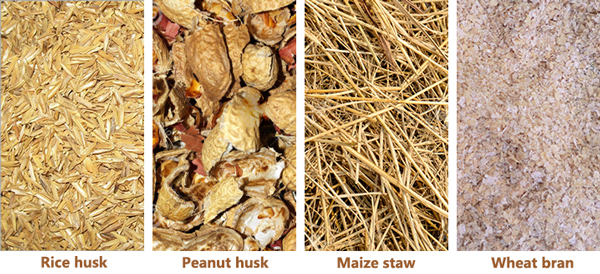
Which crop residues, such as Rice Straw, Wheat Straw, Bagasse, Maize Stalks, Cotton Stalks, Groundnut Shells, Soybean Stalks, Mustard Stalks, Sorghum Stalks, and Barley Straw, are commonly used for biomass pellet production in India?
In India, various crop residues are used for making biomass pellets. These residues are abundant and represent a potential source of renewable energy. The choice of crop residue for biomass pellet production depends on factors such as regional availability, crop patterns, and the characteristics of the residues. Here are some of the major Indian crop residues used for making biomass pellets:

· Rice Straw (चावल का पुआल)
- GCV: 3,200-3,500 kcal/kg
- Density: 80-120 kg/m³
- Ash Content: 15-20%
- Description: A significant residue after rice harvesting, abundant in regions like Punjab and Haryana.
· Wheat Straw (गेहूं का पुआल)
- GCV: 3,400-3,800 kcal/kg
- Density: 90-120 kg/m³
- Ash Content: 8-12%
- Description: Common residue after wheat harvest, typically used in areas such as Uttar Pradesh and Rajasthan.
· Bagasse (गन्ने की खोई)
- GCV: 2,000-2,300 kcal/kg (as-fired), 4,000-4,500 kcal/kg (dry)
- Density: 120-150 kg/m³
- Ash Content: 1.5-3%
- Description: The fibrous by-product after sugarcane juice extraction, widely used in Maharashtra and Karnataka.
· Maize (Corn) Stalks (मकई के डंठल)
- GCV: 3,300-3,600 kcal/kg
- Density: 100-150 kg/m³
- Ash Content: 5-7%
- Description: Generated after maize harvesting, common in states like Bihar and Madhya Pradesh.
· Cotton Stalks (कपास के डंठल)
- GCV: 3,200-3,500 kcal/kg
- Density: 130-150 kg/m³
- Ash Content: 3-6%
- Description: A by-product from cotton fields, found in regions such as Gujarat and Maharashtra.
· Groundnut (Peanut) Shells (मूंगफली के छिलके)
- GCV: 4,100-4,500 kcal/kg
- Density: 200-250 kg/m³
- Ash Content: 2-4%
- Description: A by-product of groundnut processing, prevalent in Gujarat and Tamil Nadu.
· Soybean Stalks (सोयाबीन के डंठल)
- GCV: 3,200-3,500 kcal/kg
- Density: 90-130 kg/m³
- Ash Content: 5-8%
- Description: Residue from soybean cultivation, especially in Madhya Pradesh and Maharashtra.
· Mustard Stalks (सरसों के डंठल)
- GCV: 3,400-3,700 kcal/kg
- Density: 110-150 kg/m³
- Ash Content: 6-9%
- Description: Residue from mustard fields, commonly used in Rajasthan and Haryana.
· Sorghum Stalks (ज्वार के डंठल)
- GCV: 3,300-3,600 kcal/kg
- Density: 100-130 kg/m³
- Ash Content: 5-8%
- Description: Harvest residue from sorghum, typically found in Maharashtra and Andhra Pradesh.
· Barley Straw (जौ का पुआल)
- GCV: 3,300-3,600 kcal/kg
- Density: 80-110 kg/m³
- Ash Content: 8-10%
- Description: Residue from barley harvesting, mostly used in northern India.
· Sunflower Stalks (सूरजमुखी के डंठल)
- GCV: 3,400-3,700 kcal/kg
- Density: 100-140 kg/m³
- Ash Content: 4-7%
- Description: Residue after sunflower harvesting, used in Karnataka and Andhra Pradesh.
· Rapeseed (Canola) Residues (तारामीरा के अवशेष)
- GCV: 3,300-3,500 kcal/kg
- Density: 90-130 kg/m³
- Ash Content: 5-8%
- Description: Harvest residue from rapeseed, found in northern India.
· Paddy Husk (धान की भूसी)
- GCV: 3,000-3,400 kcal/kg
- Density: 100-120 kg/m³
- Ash Content: 15-20%
- Description: The outer shell of rice, a by-product of rice milling with high silica content, common in West Bengal and Tamil Nadu.
· Sugarcane Leaves (गन्ने के पत्ते)
- GCV: 2,800-3,200 kcal/kg
- Density: 80-100 kg/m³
- Ash Content: 6-10%
- Description: Leaves from sugarcane plants, collected along with bagasse in regions like Uttar Pradesh and Maharashtra.
· Millet Residues (बाजरा के अवशेष)
- GCV: 3,300-3,500 kcal/kg
- Density: 90-120 kg/m³
- Ash Content: 5-8%
- Description: Residue from millet crops, found in Rajasthan and Gujarat.
These crop residues are often collected from agricultural fields after the primary crop harvest. Biomass pelletization of these residues not only provides a renewable energy source but also helps in the efficient management of agricultural waste, reducing environmental impacts. The utilization of crop residues for biomass pellets aligns with sustainable practices and contributes to India’s efforts to promote clean energy and reduce greenhouse gas emissions.

